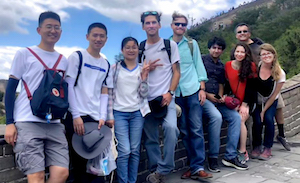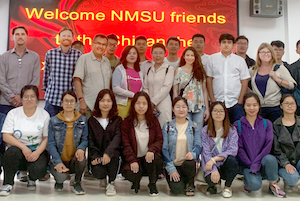 Three China Agricultural University graduate students join New Mexico State University College of Agricultural, Consumer and Enviromental Science graduate students, from left, Curt Pierce, Jeremy Schallner, Esmaiil Mokari, Shanelle Trail and Emily Creegan, and NMSU associate professor David DuBoise visiting the Great Wall of China. (Courtesy photo)Five New Mexico State University graduate students saw up-close the impact of desertification due to drought and man-induced water shortage, and the efforts of the common-person to reclaim their ancestral lands
Three China Agricultural University graduate students join New Mexico State University College of Agricultural, Consumer and Enviromental Science graduate students, from left, Curt Pierce, Jeremy Schallner, Esmaiil Mokari, Shanelle Trail and Emily Creegan, and NMSU associate professor David DuBoise visiting the Great Wall of China. (Courtesy photo)Five New Mexico State University graduate students saw up-close the impact of desertification due to drought and man-induced water shortage, and the efforts of the common-person to reclaim their ancestral lands
The Aggies Go Global students were touring Shiyanghe Experimental Station and project sites in the Shiyang River Basin in Gansu Province in northwest China as part of a NMSU-China Agricultural University 1+1 Graduate Exchange program.
College of Agricultural, Consumer and Environmental Sciences graduate students Emily Creegan, Esmaiil Mokari, Curt Pierce, Jeremy Schallner and Shanelle Trail; and NMSU associate professor David DuBois joined China graduate students and faculty for a water conservation convergence on high-efficient water use in agriculture.
 New Mexico State University graduate students Emily Creegan, Esmaiil Mokari, Curt Pierce, Jeremy Schallner and Shanelle Trail; and NMSU associate professor David DuBois among Chinese students and faculty at the China Agricultural University in Beijing. (Courtesy Photo)“Five years ago the NMSU-CAU Water Science and Engineering Joint Research Center was created,” said Manoj Shukla, NMSU coordinator of the ACES Global Initiative program. “Each year NMSU faculty members have visited China to participate in this program. This spring during a trip attended by Dean Rolando A. Flores it was agreed to have a program for graduate students to meet and share their research.”
New Mexico State University graduate students Emily Creegan, Esmaiil Mokari, Curt Pierce, Jeremy Schallner and Shanelle Trail; and NMSU associate professor David DuBois among Chinese students and faculty at the China Agricultural University in Beijing. (Courtesy Photo)“Five years ago the NMSU-CAU Water Science and Engineering Joint Research Center was created,” said Manoj Shukla, NMSU coordinator of the ACES Global Initiative program. “Each year NMSU faculty members have visited China to participate in this program. This spring during a trip attended by Dean Rolando A. Flores it was agreed to have a program for graduate students to meet and share their research.”
During the opening day of the students’ trip, each participant shared their research relating to water or water conservation.
“Both of our countries are facing similar issues in regard to climate change and drought,” said Schallner, an animal and range science graduate research assistant. “We learned what they are doing to address these issues.”
The remainder of the trip involved touring ecological restoration projects in the Shiyanghe River Basin, 1,000 miles west of Beijing, on the southern edge of the Gobi Desert. They visited the demonstration area of the desertification control in Laohukou of Minquin County.
On the way to the restoration projects, the group toured the Shiyanghe Experimental Station at Wuwei City where a variety of experiments on water-saving irrigation technologies are being conducted.
“I was very impressed to see the experimental station,” said Mokari, a plant and environmental sciences graduate research assistant. “I have read about this amazing modern experimental station in many research papers.”
Surrounded by the Badain Jaran and Tengger deserts, the Shiyang River Basin has suffered severe desertification for more than 50 years because of the draining of the river basin aquifer.
Desertification is a type of land degradation in which a relatively dry area of land becomes a desert, typically losing its bodies of water as well as vegetation and wildlife.
“The encroachment of the sand and multiple dust storms damaged the local communities in many ways,” said Trail, an ag economics and ag business graduate research assistant. “People were losing their livelihood and food source.”
An effort to reverse the desertification has been mounted by the Chinese government and community members in the area.
“While the ecological challenges facing the Chinese people are significant, no one can question their resolve to face them head-on,” said Pierce, a plant and environmental science graduate research assistant. “You cannot help but be impressed with the scale of their effort.”
“It was amazing to see miles and miles of plants that have been planted by people to stabilize the arid soil system,” said Creegan, a plant and environmental sciences graduate research assistant. “It was really powerful to experience real-world research and then to see what is happening within the community. There seemed to be a passion, a desire to reverse the desertification.”
During a visit to a museum that showcased the restoration project, DuBois said the group learned how the people had woven sticks together creating mats to protect the newly planted plants’ root systems from wind caused soil erosion.
“It was amazing that they hand-watered hundreds of little bushes that they had planted,’ DuBois said.